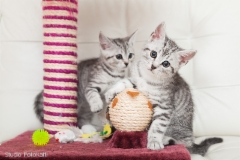|
The European Shorthair Cat The European Shorthair Cat (EUR), for which a standard was not established until the beginning of 1980s by FIFe, the International Pedigree Cat Association, is one of the most popular shorthaired breeds in Finland. It is most likely due to the fact that this originally European breed has preserved its purity fairly well in Northern Europe until these days. In Finland it has not been mixed with other breeds, neither with those that are bred artificially nor with those imported from abroad. Moreover, they have mostly been bred in Finland without any contacts with the British shorthair breed, in spite of the fact that until lately they lacked an established standard. That is why Finland has succeeded in preserving the purity of the registered European shorthair cats - an absolute must for all these cats, presupposed by the present standard. Many international feline judges think that not only is the Finnish stock of Europeans large but also of very high quality: the cats fulfill the requirements remarkably well. Finnish cats of this breed have had pretty much success in cat shows both in Finland and abroad. Also the best shorthaired cats in the shows have often been of the European breed. The colour range of these Finnish pedigree cats corresponds rather well with that of the original wild European breed. Although FIFe has accepted some new colour variations during the last few years - there are more than 70 of them - in Finland organized and active breeding concentrates on 15-20 classical variations. Among the types of patterned colourings, the most common variations are tabby mackerel, tabby blotched and tabby spotted. The colour combinations of these patterns are usually following: silver (-black), black (-brown) and red. The most popular solid variant is black. The so-called "tortoise-shell" variation repers to a cat with a red-and-black colour pattern. This pattern can also have a bit of white, and this type is called "tortoise-shell and white". The bottom layer of a smoke-coloured cat's fur is silver and the top is darker; European shorthair cats are usually of the black-smoke types. For a registered European shorthair cat it is important to be large or medium-large in size, strongly built and muscular, but not cobby. FIFe has given out a detailed standard. European shorthair cats are more temperamental than for example longhaired cats; they are sociable and adaptable. They are playful but not too lively. The FIFe standard for the European shorthair cat is based on the average domestic cat, but it should be noted that this refers back to the old domestic breed, and not all present domestic cats, which vary a lot in build, are of this type, which is due to the mixing of breeds, mutations and spontaneous inbreeding. Only quite rarely is it possible to find domestic cats whose colouring, build and general type fulfills the European standard so well that they can be registered in the novice class. Thus, in general, domestic cats cannot be considered as being of the European shorthair breed. The Finnish European Shorthair Cat Club (SER-FER) was founded in 1987. It is the European Shorthair breeders' organization. The function of the Club is the promotion of organized and well-planned breeding of European shorthair cats. It gives advice, acts as the exhange agent of kittens and males for breeding, organizes special shows for European cats (without judges) and publishes its own periodical called Serry four times a year.
|

